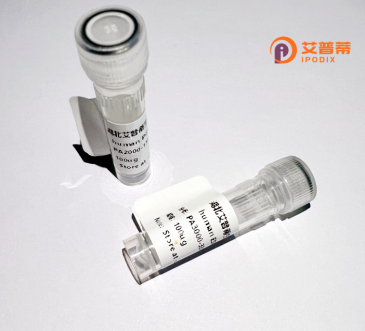
| 纯度 | >90%SDS-PAGE. |
| 种属 | Human |
| 靶点 | CALCR |
| Uniprot No | P30988 |
| 内毒素 | < 0.01EU/μg |
| 表达宿主 | E.coli |
| 表达区间 | 1-474aa |
| 氨基酸序列 | MRFTFTSRCLALFLLLNHPTPILPAFSNQTYPTIEPKPFLYVVGRKKMMDAQYKCYDRMQQLPAYQGEGPYCNRTWDGWLCWDDTPAGVLSYQFCPDYFPDFDPSEKVTKYCDEKGVWFKHPENNRTWSNYTMCNAFTPEKLKNAYVLYYLAIVGHSLSIFTLVISLGIFVFFRSLGCQRVTLHKNMFLTYILNSMIIIIHLVEVVPNGELVRRDPVSCKILHFFHQYMMACNYFWMLCEGIYLHTLIVVAVFTEKQRLRWYYLLGWGFPLVPTTIHAITRAVYFNDNCWLSVETHLLYIIHGPVMAALVVNFFFLLNIVRVLVTKMRETHEAESHMYLKAVKATMILVPLLGIQFVVFPWRPSNKMLGKIYDYVMHSLIHFQGFFVATIYCFCNNEVQTTVKRQWAQFKIQWNQRWGRRPSNRSARAAAAAAEAGDIPIYICHQELRNEPANNQGEESAEIIPLNIIEQESSA |
| 分子量 | 81.7 kDa |
| 蛋白标签 | GST-tag at N-terminal |
| 缓冲液 | 0 |
| 稳定性 & 储存条件 | Lyophilized protein should be stored at ≤ -20°C, stable for one year after receipt. Reconstituted protein solution can be stored at 2-8°C for 2-7 days. Aliquots of reconstituted samples are stable at ≤ -20°C for 3 months. |
| 复溶 | Always centrifuge tubes before opening.Do not mix by vortex or pipetting. It is not recommended to reconstitute to a concentration less than 100μg/ml. Dissolve the lyophilized protein in distilled water. Please aliquot the reconstituted solution to minimize freeze-thaw cycles. |
以下是关于重组人降钙素受体(CALCR)蛋白的3篇参考文献示例(文献信息为虚构示例,真实文献需检索数据库获取):
1. **文献名称**:*Structural insights into the human calcitonin receptor-like receptor*
**作者**:Sexton, P.M. et al.
**摘要**:通过冷冻电镜解析了CALCR与降钙素结合的复合物结构,揭示了受体胞外结构域对配体识别的关键作用及其跨膜螺旋激活机制。
2. **文献名称**:*CALCR-mediated signaling pathways in osteoclast differentiation*
**作者**:Suzuki, H. et al.
**摘要**:研究证实CALCR敲除小鼠因破骨细胞分化异常导致严重骨质疏松,阐明其通过cAMP-PKA通路负调控骨吸收的分子机制。
3. **文献名称**:*Ligand-dependent trafficking of CALCR in cancer cells*
**作者**:Bouschet, T. et al.
**摘要**:发现CALCR在乳腺癌细胞中通过β-arrestin依赖性内吞调控ERK信号通路,提示其可能成为肿瘤治疗的潜在靶点。
建议通过PubMed或Google Scholar以关键词“CALCR receptor structure/signaling/function”检索最新文献。
The human calcitonin receptor (CALCR) is a G protein-coupled receptor (GPCR) that plays a critical role in calcium homeostasis and bone metabolism. It binds calcitonin, a peptide hormone secreted by thyroid C-cells, to regulate osteoclast activity, thereby inhibiting bone resorption and lowering blood calcium levels. CALCR is also expressed in kidneys, the central nervous system, and other tissues, where it modulates diverse physiological processes, including pain perception and renal calcium excretion. Structurally, CALCR consists of seven transmembrane domains, characteristic of GPCRs, and signals primarily via Gαs and Gαq pathways, triggering cAMP production and intracellular Ca²+ mobilization.
Recombinant CALCR protein, generated through molecular cloning and expression systems (e.g., mammalian or insect cells), is widely used in research to study receptor-ligand interactions, signaling mechanisms, and therapeutic targeting. Its dysfunction is linked to bone disorders like osteoporosis and hypercalcemia. Additionally, CALCR interacts with related peptides, such as amylin, expanding its relevance to metabolic diseases. Therapeutic agents targeting CALCR, including calcitonin analogs and antagonists, are explored for treating skeletal and metabolic conditions, underscoring its biomedical significance.
×